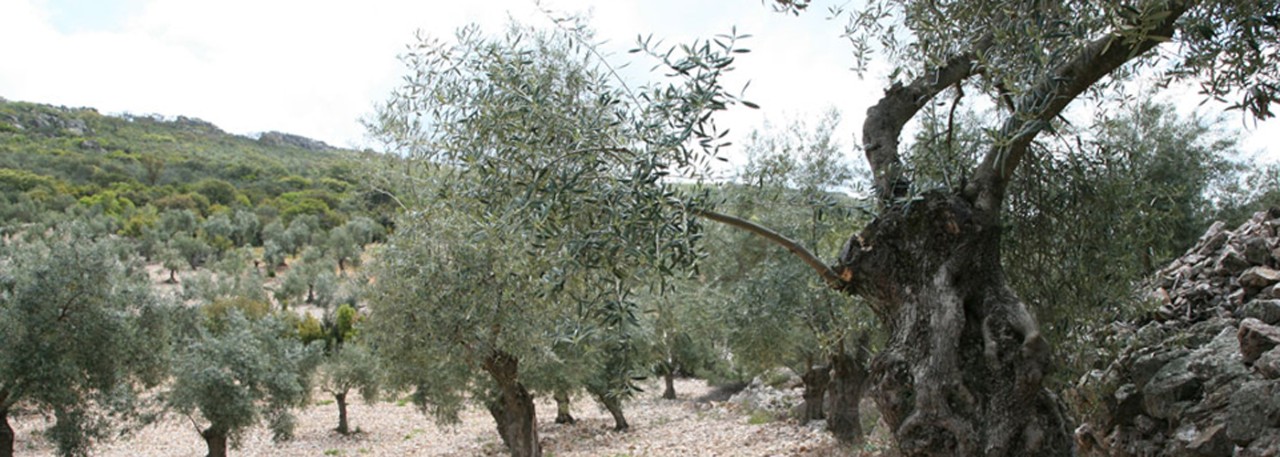.png.transform/rendition-xs/image_image%20(1).png)
Aceite de Monterrubio PDO
Extra virgin olive oil obtained from the fruit of the olive tree (Olea europaea L.), with 90% coming from the Cornezuelo and Jabata (Picual) varieties and the remainder from Mollar, Corniche, Pico-limón, Morilla and Cornicabra.
Tasting notes
An aromatic, very stable oil with a greenish-yellow color. The flavor is fruity, with almond notes and a touch of bitterness and pungency.
Other notes
The analytical characteristics are as follows:
- Maximum acidity: 0.5º
- Moisture: Below 0.1%
- Impurities: Below 0.1%
- K270: Below 0.20
- Peroxides: Below 20.
Production / Processing method
With regard to cultivation techniques, tilling is becoming increasingly light, with just a few passes of the cultivator. Today there are two types of fertilization: mineral (applied via the leaves and the soil) and organic (applied directly to the soil, mainly pig manure).
Pruning is traditionally carried out after harvesting, from February to late March. It is done manually or by machine and must not be aggressive. Once a year (late summer) or twice (early and late summer), any shoots at ground level are removed, a technique developed in ancient times.
Most olive orchards are dry-farmed in line with tradition, but the current trend is to introduce drip irrigation. Only olives picked directly from the tree may be used to make olive oil, not those that have fallen to the ground. Harvesting has traditionally been done by hand, and still is, although mechanical harvesters (vibrators with or without an umbrella) are increasingly being used. In order to obtain PDO virgin olive oils, it is very important that no more than 66 hours should pass between harvesting of the olives and extraction of the oil, although this time limit is established annually by the Regulating Council based on the harvesting characteristics and weather conditions.
The processes used for obtaining the olive oil are:
- Discontinuous or traditional extraction:
Any foreign matter (leaves, stones, etc.) is first removed in the field. Once in the mill, the olives are washed then crushed into a paste using cone-shaped, granite grinding stones turning over a circular granite millstone. The duration of crushing and mixing is decisive for oil quality and must be adapted to the olive variety. The resulting paste is spread on esparto mats which are piled up and pressed. The oil and vegetable water run down the sides and the central channel, leaving just the pomace on the mats. After extraction, the load is dismantled, the oil is separated from the vegetable water by decantantation, and the oil is stored.
- Continuous extraction:
With this method, the olives are cleaned not in the field but at the mill using blowers (to remove any objects that weigh less than the olives), and then washed (to dissolve any objects heavier than the olives).
Crushing then begins using a knife crusher. Hot water is added to the resulting paste to facilitate the next phase, oil extraction, which is by centrifugation. Horizontal or vertical centrifuges may be used. The process must be repeated to separate the vegetable water from the oil.The oil is then decanted to remove any impurities and, when clear, is stored. Finally, it is packed. Packs must be glass or metal.
The most important of these two processes is the continuous one as it is the most widely used and gives the best yield. However, in some mills in the production area, the two methods are used in combination.
Geography / Relief and climate
The geographical area for growing olives and producing oil is south Extremadura (west-central Spain) in the foothills of the Sierra Morena. The land is rugged but the hills are not high. The olive orchards grow alongside holm oak woods and cereal farms, with scrubland occupying most of the higher areas, this being the typical Mediterranean landscape in which low rainfall makes any other type of farming impossible. There are two main altitudes – the peneplain, at 300-500 m / 984-1,640 ft and the Sierras, at 600-800 m / 1,968-2,624 ft. The valleys are used for cereals, vines and olive trees, and the slopes for large olive orchards and holm oaks. Higher up there is scrub, stony ground and quartz scree. Olives are mostly grown on clay-loam soils, although in recent years lighter soils are also being used. pH is acid to slightly acid. Soil depth varies, with parts in which slate is visible and others where depth is over 50 cm / 19 in and water retention is good. The climate is Mediterranean, with some features of continental, tempered by proximity to the Atlantic ocean. Winters are mild and summers long and hot. Rainfall is below 500 mm. The average temperature is 16-18ºC / 60-64ºF, reaching a maximum of 40ºC / 104ºF in summer.
Regulatory Council
Consejo Regulador de la DOP Aceite de Monterrubio
C/ Nicanor Guerrero, 9
06427 Monterrubio de la Serena (Badajoz)
Extremadura
Tel: (+34) 924 635 371
domonterrubio@terra.com
www.aceitemonterrubiodop.es
Sources:
- Spanish Ministry of Agriculture
The continuous extraction is the most widely used and gives the best yield.


- Aceite de Monterrubio 1
- Aceite de Monterrubio 2

Monterrubio de la Serena (Extremadura)
